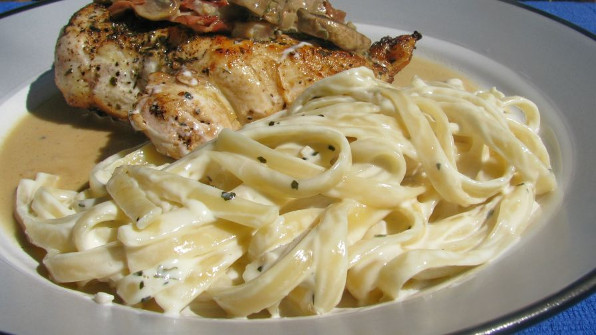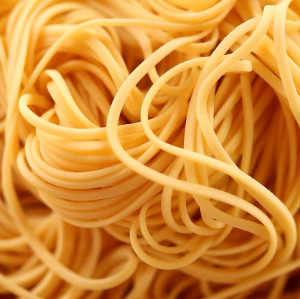We’ve all boiled up a pot of Spaghetti at least once in our culinary lives. But did you know there’s a lot more to it than just Water and Pasta? I learned some invaluable secrets for making perfect Pasta from a real Italian Mama when I was little. Now, I’m going to share them with you!
 Classic Linguini Alfredo as a side for a nice piece of Roasted Chicken.
Classic Linguini Alfredo as a side for a nice piece of Roasted Chicken.
In fact versatile Alfredo goes with almost anything, Italian or not!
The lady across the street, Mrs. Indovino, hosted me after school a couple of afternoons a week, when my mother was volunteering at the church. I’d get there just in time to watch her make supper for her large family, and that usually involved Pasta of some kind.
From her, I learned the first rule of cooking Pasta: Salt the cooking Water generously. Adding Salt before adding the Pasta to the Water ensures that the Pasta gets enough Salt, through absorption, that it won’t taste bland or pasty.
And use lots of Water in a big pot. You want the Pasta top swim freely while cooking, not huddle passively in a lump which will more than likely stick together when you try to serve it.
NEVER, EVER put Oil in the cooking Water! Oil in he Water will keep your pasta from cooking properly and keep the Sauce from coating the Pasta properly at serving time.
When cooking, keep the temperature high so that the water boils vigorously, stirring the Pasta via its bubblings and churnings. Mrs. I never stirred her pasta more than once, right at the beginning when she added it to the pot.
When she wasn’t preparing Spaghetti or Fettuccini or some other long Noodle, Mrs. I used only hollow types like Penne or Elbows, or twisty varieties like Roitini or Fusilli, which had cavities or channels to hold the sauce. Nobody at her house ever needed a spoon to clean up the sauce from the bottom of their plate after the Pasta was gone.
Most Italian cooks always prepare Pasta to the al dente (‘to the tooth’) stage in the pot. They don’t eat it that way, though. The Pasta cooks for a second time in a frying pan when it’s is added to the Sauce and gets a chance to mingle and absorb flavour. You won’t believe what you’ve been missing if you’ve just been dumping Pasta on a plate and pouring the Sauce on top!
If you like your Pasta Sauces creamy, you’ll want to save some of the Pasta cooking water – maybe half a cup / 125 ml. Add that to the frying pan when the Pasta is simmering there, coming back up to temperature. The cooking water is full of dissolved starches from the Pasta which will help thicken the sauce and make it adhere to the Pasta better.
Now you know everything I do about cooking Pasta the right way. Try it tonight!
~ Maggie J.

